Table of Contents
The Inspiration
Over the past few weeks I have felt called to write about an often uncovered yet extremely important component of the therapeutic process: Patient interaction.
We had an instance in which I came back into the clinic from my lunch break and my intern was supposed to have a patient evaluation. Instead, she opted to have me take this particular patient. This patient was a lovely 17 year old lady who was being seen for bilateral foot pain. This was her second bout of therapy, and her and her mother was very dissatisfied with their last physical therapy experience just a few months (and 17 visits) prior. She was not a happy camper and wanted a second opinion. After hearing stories from my coworkers, I expected the worst.
We progress through the evaluation, and my student observes nothing but smiles throughout from the patient and her mom. Jokes were cracked, movement was looked at, and edumacation happened. At this point, after a little explain pain and kinetic chain discussion, these women were sold.
We leave the treatment room and I said “that wasn’t so bad yes?” My student replies “that’s because they are in love with you.”
But really, that essentially is what you have to do with the patient interaction. You can have the greatest hands, the greatest exercise plan, and evidence up the wazoo; but if your patient hates your guts you will fail. I heard this from Patrick Ward that 80% of your success with patients depends on if they like you. A recent RCT supports this notion as well. You have to get your patient to fall in love with you and your approach, in a nonsexual manner of course.
While I am neither aware nor sure if possible there exists any evidence regarding the best way to interact with a patient, I am going to run through how I approach the patient experience. I don’t know if my way is the most successful or even the best way, but I generally get good patient satisfaction reviews so deal with it.
The Goal
Here is what an excellent patient interaction achieves:
1) Reduced threat perception.
2) Establishes a bond and rapport.
3) Maximizes placebo effect.
4) Makes rehab fun.
If you read The Polyvagal Theory, Stephen Porges discusses neuroception, which is basically how your nervous system responds to situations after evaluating all given sensory input. If your autonomic nervous system perceives someone or something as threatening you will either fight, flight, or freeze. The goal then, is to make the patient feel safe when working with you. This shift allows for decreased sympathetic response and increased prosocial behavior, both necessary and influential when working with pain states.
The patient interaction is also a great way to get the placebo effect. I know the placebo effect often is thought of as deceitful and providing ineffective treatment, but that is far from the truth. All the placebo effect does is maximize the belief and perception that a treatment will work. In fact, the belief that something will work is part of a recent CPR developed for cervical spine manipulation in neck pain. In On Intelligence, perception and behavior are one and the same. So by optimizing one’s perception, we can optimize one’s motor behaviors.
Moreover, I think it is important to have fun with what you do, and make the physical therapy experience a pleasant and rewarding time for all involved. Think of how we are perceived; “PT stands for pain and torture,” or “I hate physical therapy.” Adding humor and performing fun activities can make PT a more fruitful time.
Seeing how my student has been progressing is a good example of this. When she first started out, much of the focus was geared toward getting all the relevant information, making sure she was performing all the tests, manual therapy, and exercises well. One thing that was really lacking was the patient interaction. After stepping in a few times when she struggled, you could see some of her patients just open up and smile during our short stint together. After explaining the above to her, my intern is now asking patients about their life stories, weekend plans, and empathizing with their problems. She is even stealing some of my jokes, which is okay because half of my material is not original.
The Greeting
The first impression is very meaningful and sets the tone for the patient interaction. When I meet a patient for the first time, I will call them by name and have them walk to me. I get several pieces of information from this introduction:
1) Their sitting posture.
2) Their facial expression when you make eye contact.
3) How they get out of the chair.
4) Their gait pattern and speed.
These pieces help me understand how well and willing the patient moves, as well as their general demeanor. Depending on if I see someone hop right up with a huge smile on their face versus someone who is slouched in their seat and slowly trudges over towards me, my interaction with them often changes. With the former, I will be more upbeat, with the latter, I will be mellow. The more you can mirror the patient, the greater bond you can develop.
The Handshake
This small gesture reveals so much about your patient. The firmness and way they shake your hand can tell you a lot about their personality. There are several different handshakes you may experience:
Which you should use depends on how you wish to be perceived. If I see someone who seems to need more guidance, I may use a more dominant type of handshake. If I see someone who needs reassurance, I may use a more submissive handshake. Regardless of how you shake one’s hand, make sure you use firm pressure and warm eye contact.
The Subjective
The subjective examination is very important, but not for the reasons you think. I know my mentors in my residency will kill me, but I personally do not feel the subjective examination really steers me in a particular treatment direction. Rather, I see the following as the subjective exam’s goals:
1) Find out how you may help them.
2) Establish rapport.
3) Understand the patient and their story.
4) Make the patient feel understood.
5) Rule out red flags.
You obviously want to find out what brings them to you, but for me the objective tells me where to go. The subjective examination is more for the patient than you, so let’s talk about how to maximize that interaction.
The Setup
How you face the patient can make or break your interaction. Remember the goal is to reduce threat perception and make them feel comfortable with you. To maximize this goal, you want to eliminate as many barriers as possible. So you probably do not want to face the patient like this…
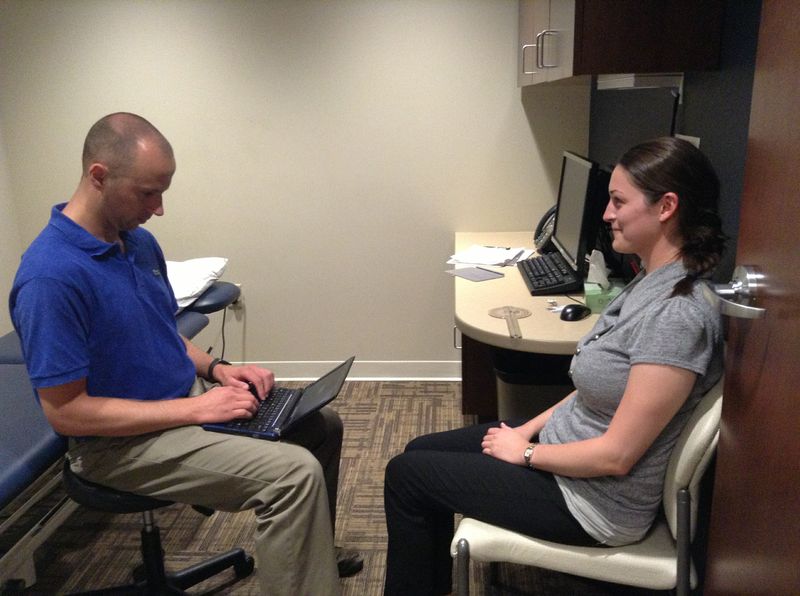
Or This
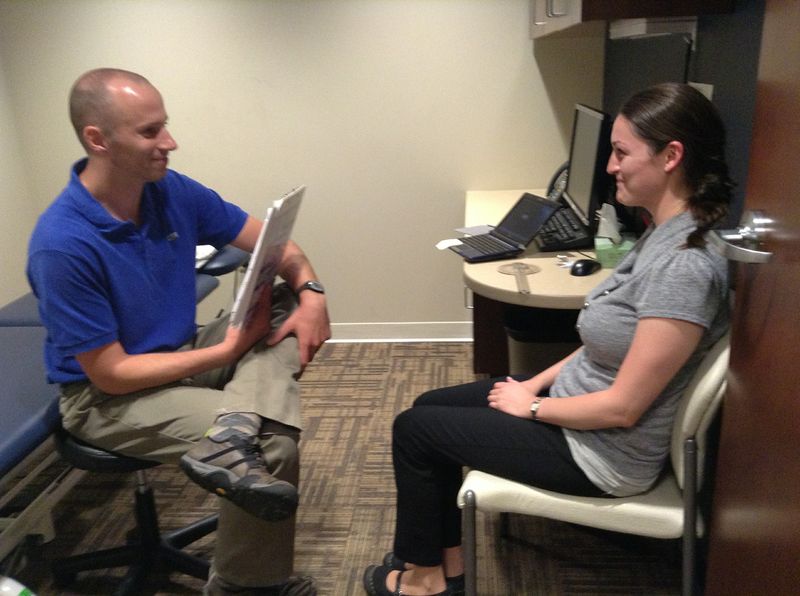
Or this
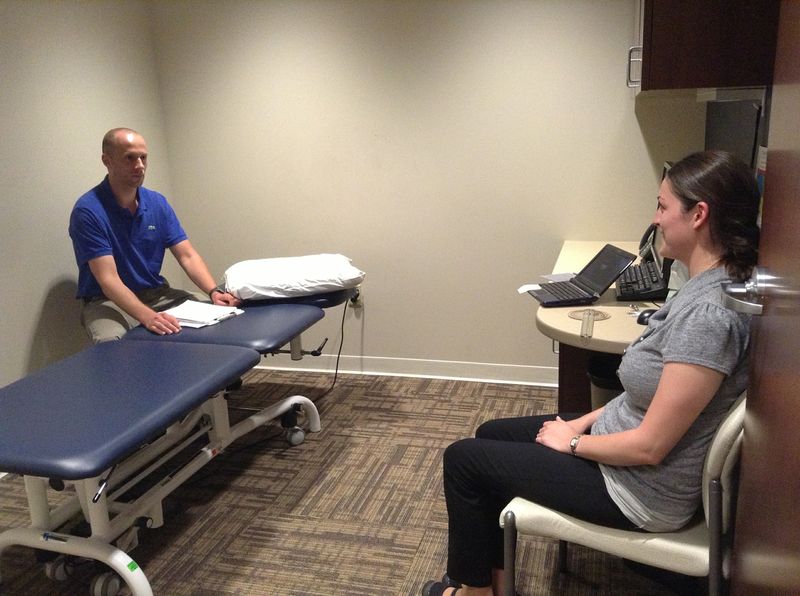
Or this
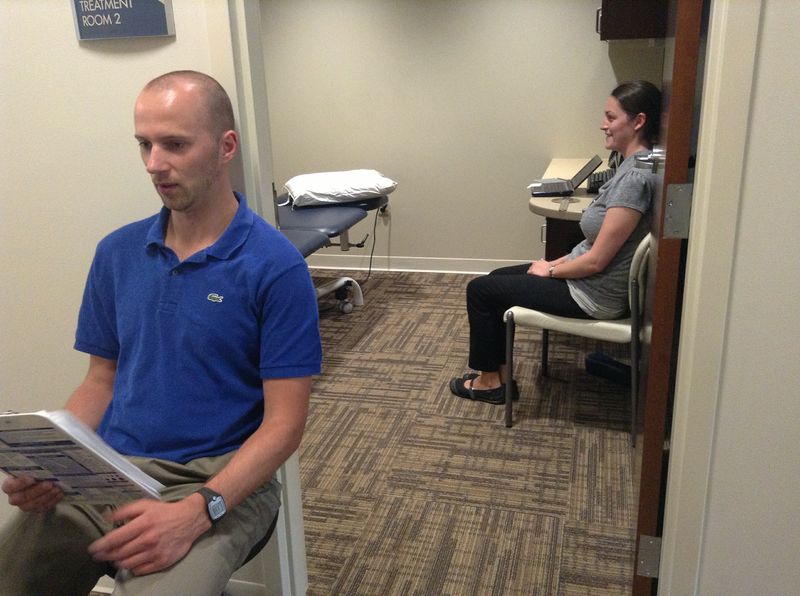
And definitely not this
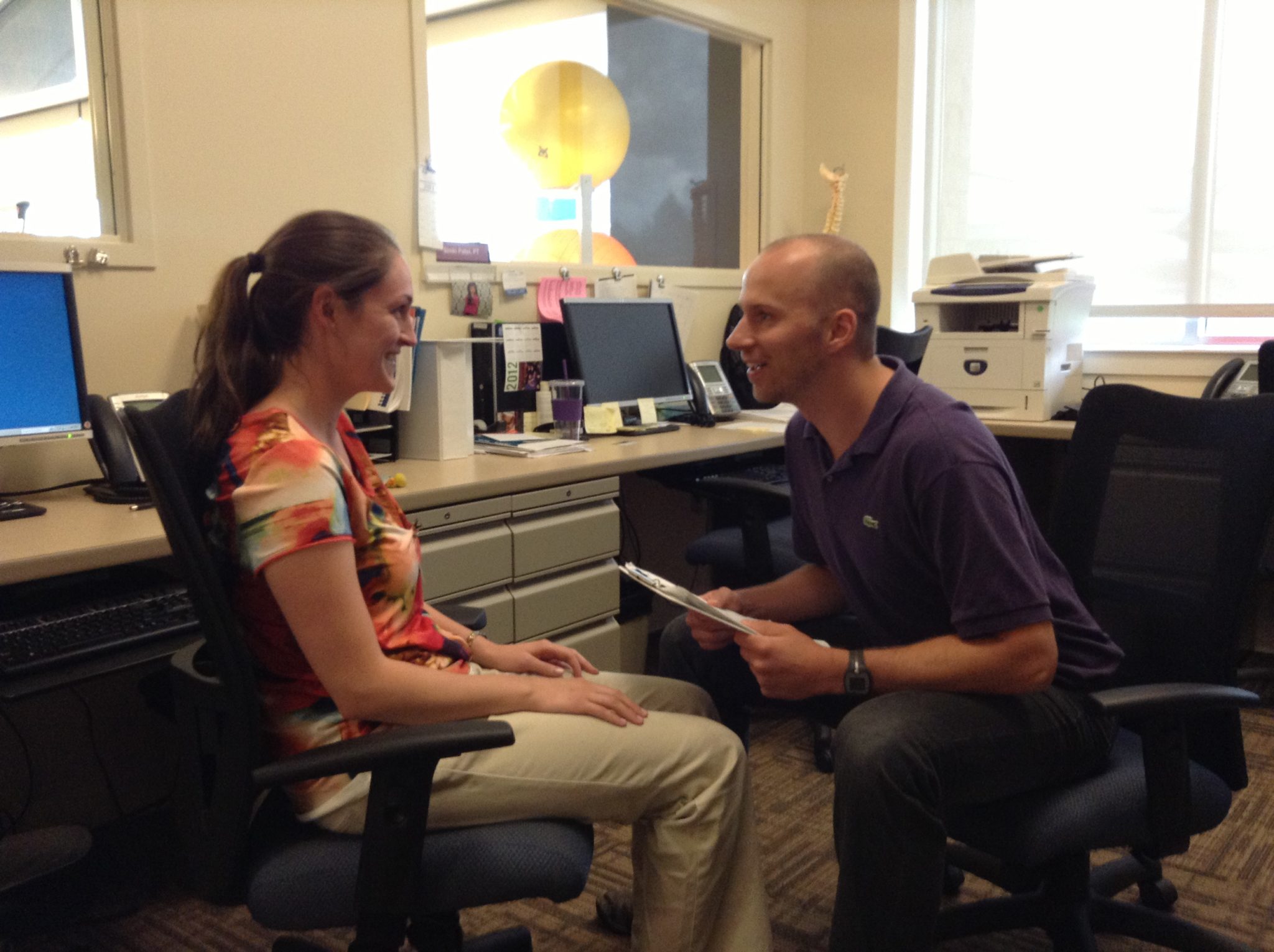
Rather, I like this orientation
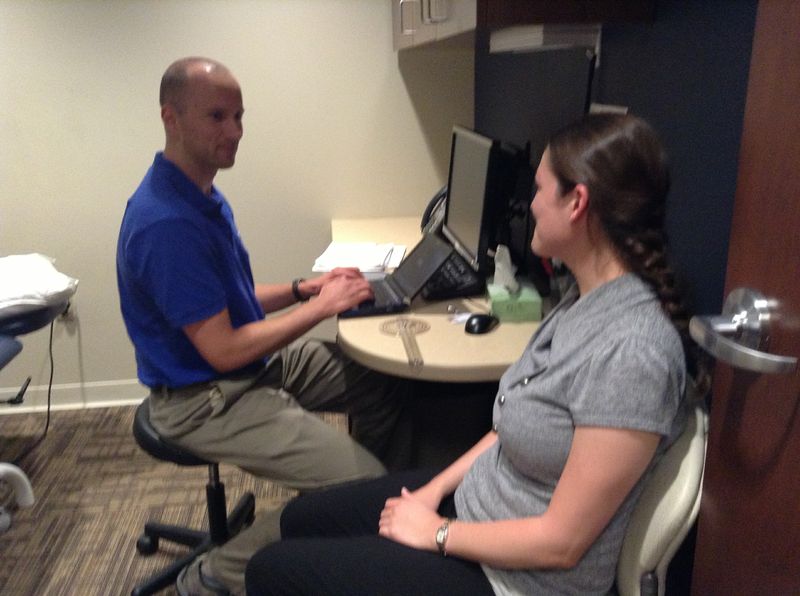
Here you are staying close to the patient while simultaneously respecting their privacy because you are not directly facing them.
Now I know what you are saying, “But Zac, you are using a computer, clearly that is going to kill rapport and act as a barrier.” I would agree to some extent, there are two things here that you ought to notice:
1) The computer is not directly in front of the patient, thus is not a barrier.
2) I maintain quite a bit of eye contact while typing.
Now granted some people may still feel uneasy about me typing in front of them, so I will usually ask if I sense that this is problematic. But you can still develop some semblance of intimacy with the patient by playing with 5 different variables.
The 5 Intimacy Variables
In order to develop an intimate experience with the patient, we can add/subtract 5 different ways to create a bond with someone:
1) Proximity
2) Eye contact
3) Touch
4) Direction
5) Saying the person’s name
The more of the above variables you utilize when you interact with someone, the more of an intimate encounter you may experience. You want to use neither too many nor too few variables when interacting with someone. Too many will make you seem creepy (and potentially send the wrong message) and too few will make you seem distant. I generally shoot for 2-3 at a time.
So if we take the above setup example, I am keeping a close proximity toward the patient and maintaining eye contact, however I am not directly facing the patient. I may modulate the interaction throughout by saying the patient’s name or providing a light touch of the arm. So here I can utilize my 2-3 variables at a time.
The Objective
While the objective’s goal is to guide your treatment plan, it can also be a great time to further build rapport. Perhaps the best way to establish that you care is by providing a thorough examination.
How many people have been to a 5 minute physician visits compared to one who may spend up to 30 minutes taking a look at you? Which physician is better liked? The fact of the matter is, people want and expect a thorough examination, so give it to them.
This is where I feel like something such as the SFMA can come in handy. People may have gone to other clinicians who just looked at the affected region, but this clinician is looking at everything, he/she must be different. So when I am performing an assessment, I generally perform something closer to the SFMA top tier and then do my own type of breakouts from that. What can I say, I’m a rebel.
Throughout the examination, I will sprinkle compliments or ask about things like their plans for the rest of the day, anything I can do to further establish rapport.
The Education
So you finished the subjective and objective, and you likely have the information that you need to treat. The post-evaluation education is the spot in which you can really win or lose people. David Butler suggests that there four questions that the patient would like answered:
1) What is wrong with me?
2) How long will it take to get better?
3) What can I do to make it better?
4) What can you do to make it better?
I will usually educate the patients to some degree on pain physiology, followed by whatever objective impairments I find that can improve upon one’s complaints. In order to maintain low threat perception, I will rarely break out models or use terms such as “motion x is crushing body part y” or “you have weak area z” or “your spine is unstable,” even if these components may be somewhat true. Reason why comes back to reducing threat perception. Seeing models of bulging discs or using some semblance of the above language tends to just freak people out and moreover is often inaccurate. People just need to know that it is safe to move, when it is safe to move, and move well when they do.
I will finish my education by asking the patient an incredibly important question. Drum roll………………………………
Do you have any questions?
Especially the case with pain neurobiology, if the patient does not understand where you are coming from, they will not be able to fully buy in to your methodology and plan. So make sure any questions the patient has are answered to the best of your ability.
The Ending
I always finish my interaction with patients with the following phrases
1) “Do you have any questions, comments, concerns, or complaints?”
2) “Is there anything else I can do for you or that I did not cover?”
I ask these questions to again establish an open communication and rapport. I want to make sure that the patient is completely satisfied with the experience that I have provided them. Moreover, finishing the session with the same ending every time they come in provides the patient with some consistency and helps establish your brand; in my case, the Zac Cupples brand.
Conclusion
So there you have it, the above methodology is how I approach a patient interaction. I have based many of these methods on what I have read regarding people interaction, so the below resources might be good to check out. If you can get your social capabilities to a high standard, the rest will take care of itself.
“The Definitive Book of Body Language” by Allen Pease
“How to Win Friends and Influence People” by Dale Carnegie
“Made to Stick” by The Heath brothers
“Influencer” by Joseph Grenny et al
“Social Intelligence” by Daniel Goleman
“Just Listen” by Mark Goulston & Keith Ferrazzi
“Never Eat Alone” by Keith Ferrazzi
“The Power of Self Confidence” by Brian Tracy
James Bond – Seriously, the way he interacts with people is gold, especially if you kill bad guys and woo women like I do in my spare time.
[…] they didn’t like you…Then improve your patient interaction skills so the next one […]
Great post Zac
Thanks Zach. Hope you have a great New Year!
[…] 5) The patient interaction may cue perception/reduction of pain depending on how you present yourself. […]
[…] reducing clinician self-confidence. For confidence is what allows us to practice in uncertainty and maximize the placebo effect, our most powerful pain reliever. The uncertain conditions which we practice in are what Butler […]
[…] is a major component to therapeutic touch, and gives us a way to build rapport and interact with our patients. When palpating the nervous system, it is important to palpate in sensitive […]
[…] central sensitization, the language provided must be spoken tactfully. The following points are important to hit […]
[…] Humor. […]
[…] The Onion Skin Model – Helps describe all the factors that go into the pain experience; including nociception, attitudes and beliefs, suffering, pain escape behaviors, and social environment. […]